Enjoying the Outdoors Safely in Grizzly Bear Country
"Being “bear aware” isn’t about fear; it’s about staying alert, taking precautions, and knowing how to respond."
Grizzly bear populations are expanding across Montana, reclaiming historic ranges once lost to human activity. While this is a conservation success, it also increases the chance of human-bear conflict, bringing more people into shared spaces with grizzly bears.
Recreating in grizzly country requires added awareness. Whether you’re a hunter deep in the backcountry, a family camping for the weekend, or a runner on favorite trail, this article outlines what anyone spending time outdoors in Montana should know.
THINK LIKE A BEAR: BE ALERT AND PREPARED
If you’re in the mountains or along a river in grizzly range, assume you’re in bear country. Grizzlies are curious, mobile, and active across a wide range of environments. Being “bear aware” isn’t about fear; it’s about staying alert, taking precautions, and knowing how to respond.
Regardless of the activity, some fundamental rules apply:
- Assume their presence: recreate as if bears are nearby, even if they aren’t seen.
- Avoiding conflict is easier than resolving one: stay alert and take steps to prevent surprise encounters.
- Behavior should drive the response: both grizzlies and black bears can be dangerous. What matters most is how the bear acts, not its species.
AVOIDING CONFLICT: BEST PRACTICES FOR ALL USERS
Travel smart
Bears generally want nothing to do with people. Give them a chance to avoid humans.
- Go in groups. Bears tend to avoid groups of three or more people.
- Stay alert. Avoid headphones and remain aware of surroundings.
- Stop frequently and make noise. Especially in thick vegetation or near running water. Human voices are more effective than bells.
- Avoid high-risk areas when possible. These include dense brush, berry patches, carcass sites, stream corridors, and areas with scavenger bird activity. If unavoidable, slow down and make noise.
- Watch for bear sign. Tracks, scat, dug-up logs, overturned rocks, clawed trees, and strong odors may indicate recent activity. If you find a carcass or observe many scavenger birds, leave the area immediately.
Keep a clean camp
Bears have an incredible sense of smell and are naturally curious. If it smells, secure it.
- Store food and garbage in certified bear-resistant containers, locked vehicles, or hung at least 10 feet high and 4 feet out from vertical supports. Note these guidelines are appropriate in Montana, but other state’s storage regulations may vary. Keep all scented items out of a tent. This includes snacks, toothpaste, deodorant, and lip balm.
- Cook and store food at least 100 yards from the sleeping area.
- Clean up thoroughly. Strain dishwater and dispose of it far from camp.
- Sink fish entrails in deep water.
- Eliminate non-food attractants like pet food, sunscreen, and scented wipes.
- Use portable electric fences in high-risk or remote camps when possible.
Time activities wisely
Grizzlies are most active at dawn, dusk, and nighttime. These periods often overlap with common recreation hours.
- Carry a headlamp if you’re out early or late.
- Avoid low-visibility areas like dense brush or streambanks.
- Make noise regularly, especially if you’re biking or trail running.
- Hunters should use caution when using game calls and avoid field dressing game at night. If leaving meat behind, hang it high and away from gut piles. Use optics (scope or binoculars) to scan the area before returning.
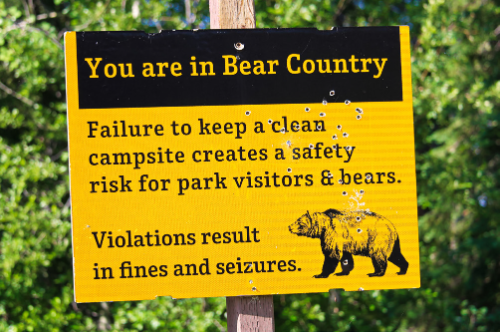
Photo: Adobe Stock
BEAR SPRAY: YOUR FIRST LINE OF DEFENSE
Bear spray is a highly effective, non-lethal deterrent. Research shows it stops aggressive bear behavior in over 90 percent of cases and prevents injury in 98 percent of close-range encounters.
Correct usage
- Carry it for easy access: on your belt, chest harness, or shoulder strap.
- Never store it in your pack.
- Practice with an inert canister. Learn to remove the safety and aim quickly.
- Point the spray towards their feet and spray when the bear is within 30-40 feet or anytime a bear is fast approaching. Don’t misuse it: It is NOT a repellent and should never be applied to people, tents, or gear.
- Check expiration dates annually.
Firearms vs. bear spray
While firearms are sometimes carried, they are harder to use effectively under stress and carry a greater risk to others. Bear spray remains the most effective tool in most bear encounters and is easier to deploy and safer for bystanders.
Regardless of which you carry, practice extensively and keep it accessible. Neither bear spray nor firearms are helpful if you don’t know how to use them or can’t access them quickly.
KNOW YOUR BEARS (BUT FOCUS ON BEHAVIOR)
While the response should be based on the bear’s actions, knowing how to distinguish grizzlies from black bears can help inform reporting and awareness (see graphic).
When in doubt, assess the body language, not the species. To see different bear behaviors watch the International Association for Bear Research and Management’s video.
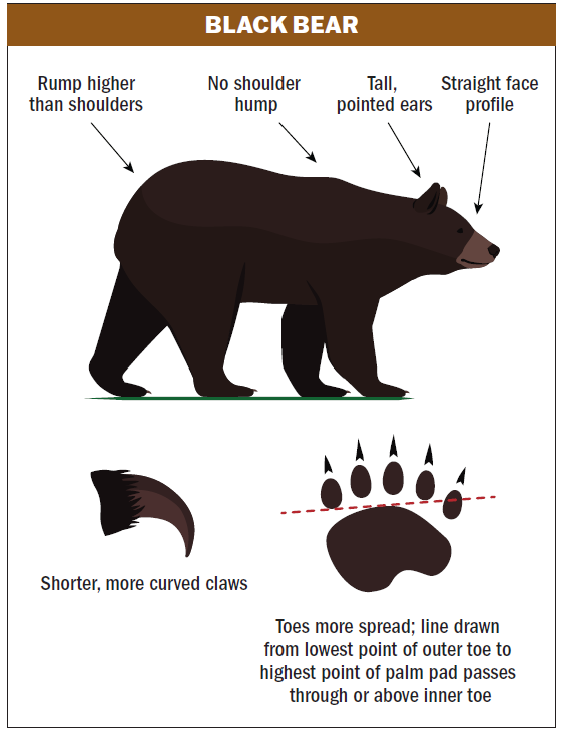
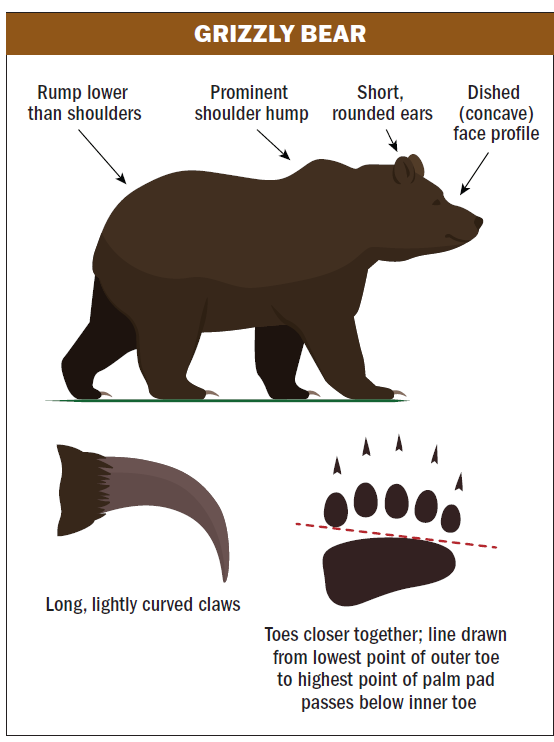
Graphics: Adobe Stock
BEFORE AND AFTER A TRIP
Before going:
- Tell someone where you’re going and when you’ll return.
- Check trailheads or agency websites for bear activity alerts.
- Pack bear spray and know how to use it.
After returning:
- Report sightings or encounters to Montana Fish, Wildlife and Parks.
- Your observations help protect others and support bear conservation.
FINAL THOUGHTS
Grizzly bears are a vital part of Montana’s wild landscapes. With the right mindset and preparation, recreating in bear country can be both safe and rewarding.
Be bear aware: Be prepared, carry bear spray, stay alert, store food properly, respond based on behavior, and enjoy all that Montana’s landscapes have to offer.
WHEN ENCOUNTERS HAPPEN, LET BEHAVIOR GUIDE YOUR RESPONSE
Despite best efforts, encounters can still happen. In these moments, your behavior matters. Do not run or approach. Let the bear’s behavior, not its species, determine the next move. First, stop. Get the bear spray ready. Observe.
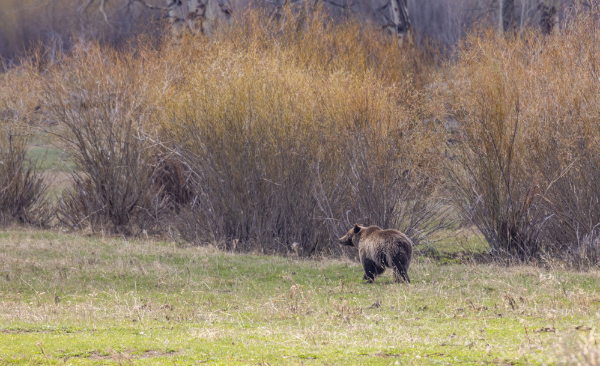
Scenario A: Bear unaware of you
What to do:
- Stay calm and quiet. Do not call out or approach.
- Slowly back away while watching the bear’s body language.
- Leave using the same route if safe.
- Keep bear spray accessible in case the situation changes.
- Even if the bear appears calm or far away, give the bear plenty of space. Never try to get a closer view or photo.
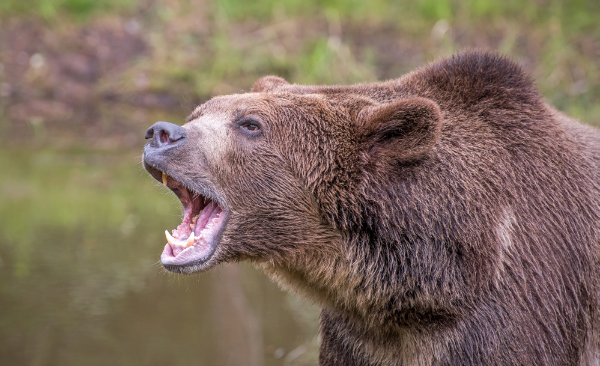
Scenario B: Defensive bear
Signs:
- Huffing, jaw popping, drooling
- Swaying or bluff charging
- Ears pinned back, vocalizing
What to do:
- Stay calm. Do not run.
- Speak softly and back away slowly.
- Do not yell or wave your arms.
- Use bear spray if the bear approaches or charges.
- If physically attacked, play dead. Lie face down, protect your neck with your arms, and keep your backpack on. Stay still until the bear leaves.

Scenario C: Curious or predatory bear
Signs:
- Silent, direct movement
- Ears up, sniffing
- Stalking behavior, entering camps or tents
What to do:
- Do not play dead.
- Stand your ground. Shout, wave your arms,
and make yourself look large. - Use bear spray if it gets within 30-40 feet.
- If attacked, fight back with everything you’ve got.
Jared Beaver is the MSU Extension Animal and Range Sciences Specialist.

